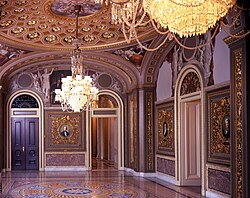
The United States Capitol, often called the Capitol or the Capitol Building, is the seat of the United States Congress, the legislative branch of the federal government. It is located on Capitol Hill at the eastern end of the National Mall in Washington, D.C. Although no longer at the geographic center of the national capital, the U.S. Capitol forms the origin point for the street-numbering system of the district as well as its four quadrants.

Arthur Hendrick Vandenberg Sr. was an American politician who served as a United States senator from Michigan from 1928 to 1951. A member of the Republican Party, he participated in the creation of the United Nations. He is best known for leading the Republican Party from a foreign policy of isolationism to one of internationalism, and supporting the Cold War, the Truman Doctrine, the Marshall Plan, and NATO. He served as president pro tempore of the United States Senate from 1947 to 1949.

Robert Ferdinand Wagner I was an American attorney and Democratic Party politician who represented the state of New York in the United States Senate from 1927 to 1949.

The Kentucky State Capitol is located in Frankfort and is the house of the three branches of the state government of the Commonwealth of Kentucky. The building is listed on the National Register of Historic Places.

The United States Senate is the upper chamber of the United States Congress, which along with the United States House of Representatives—the lower chamber—comprises the legislative branch of the federal government of the United States. Like its counterpart, the Senate was established by the United States Constitution and convened for its first meeting on March 4, 1789 at Federal Hall in New York City. The history of the institution begins prior to that date, at the 1787 Constitutional Convention, in James Madison's Virginia Plan, which proposed a bicameral national legislature, and in the controversial Connecticut Compromise, a 5–4 vote that gave small-population states disproportionate power in the Senate.
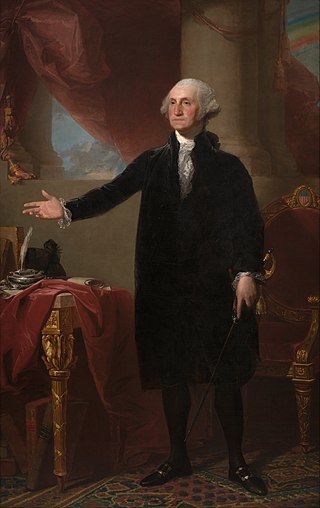
The Lansdowne portrait is an iconic life-size portrait of George Washington painted by Gilbert Stuart in 1796. It depicts the 64-year-old president of the United States during his final year in office. The portrait was a gift to former British Prime Minister William Petty, 1st Marquess of Lansdowne, and spent more than 170 years in England.

The Apotheosis of Washington is the fresco painted by Greek-Italian artist Constantino Brumidi in 1865 and visible through the oculus of the dome in the rotunda of the United States Capitol Building in Washington, D.C.

Constantino Brumidi was an Italian painter and a naturalised American citizen, best known and honored for his fresco work, Apotheosis of Washington, in the Capitol Building in Washington, DC.

Between 73 and 79 days after the presidential election, the president-elect of the United States is inaugurated as president by taking the presidential oath of office. The inauguration takes place for each new presidential term, even if the president is continuing in office for a second term.
Robert Chester La Follette, was an American painter. His portrait of his cousin Senator Robert M. La Follette, Sr. hangs in the Senate Reception Room of the United States Capitol. Allyn Cox supervised the placement of the painting in the United States Capitol.
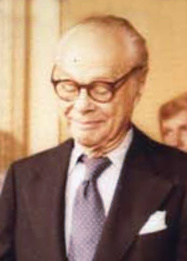
Allyn Cox was an American artist known for his murals, including those on display in the United States Capitol and the U.S. Department of State.

The United States Capitol building features a central rotunda below the Capitol dome. Built between 1818 and 1824, the rotunda has been described as the Capitol's "symbolic and physical heart".

The Brumidi Corridors are the vaulted, ornately decorated corridors on the first floor of the Senate wing in the United States Capitol.
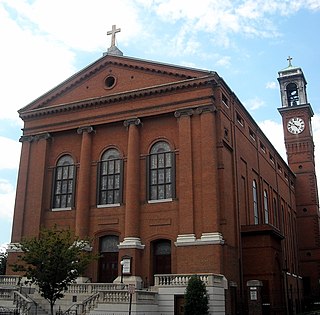
St. Aloysius Catholic Church is a Roman Catholic parish church at 19 I Street in the Near Northeast neighborhood of Washington, D. C. It is administered by the Jesuits since its founding and is named for St. Aloysius Gonzaga. It is often associated with Gonzaga College High School, to which it is physically connected. The church building is listed on the National Register of Historic Places. In 2012 the parish was closed and merged with Holy Redeemer church.

The Old Senate Chamber is a room in the United States Capitol that was the legislative chamber of the United States Senate from 1810 to 1859 and served as the Supreme Court chamber from 1860 until 1935. It was designed in Neoclassical style and is elaborately decorated. In 1976 as part of the United States Bicentennial celebrations, it was restored to the appearance of when it served the Senate in the 1850s; it is preserved as a museum and for the Senate's use.

The Hall of Columns is a more than 100-foot-long (30 m) hallway lined with 28 fluted columns in the south wing extension of the United States Capitol in Washington, D.C. It is also the gallery for 18 statues of the National Statuary Hall Collection.

The President's Room is one of the most ornate rooms in the United States Capitol, richly adorned with fresco paintings by Italian-Greek artist Constantino Brumidi. The room was completed in 1859 as part of the Capitol's vast extension, which added new Senate and House wings and the new cast-iron dome.
Carl Rakeman (1878–1965) was an American artist for the Bureau of Public Roads during the middle of the 19th century. During his career for the American government he completed 109 paintings depicting historic transportation methods in the United States.
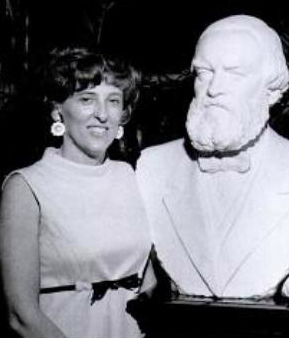
Jimilu "Mimi" Mason (1930–2019) was an American sculptor. Mason is known for her busts of notable American figures of the 1960s, including Lyndon B. Johnson, who sat for Mason many times.

The United States Senate's hideaways are about 100 secret offices in the U.S. Capitol building used by members of the Senate and by a few senior members of the U.S. House of Representatives. Their locations are unlisted in any official directory, and their doors are marked only by a room number. Senators use hideaways as a private space to prepare for sessions of the Senate, conduct confidential meetings, take naps, and for other personal purposes. They range from lavish and expansive upper-floor offices to small, cramped offices in the basement. Hideaways are assigned to senators based on seniority. The history of hideaways dates to the earliest occupancy of the U.S. Capitol in 1800. However, they proliferated in the early 20th century.
